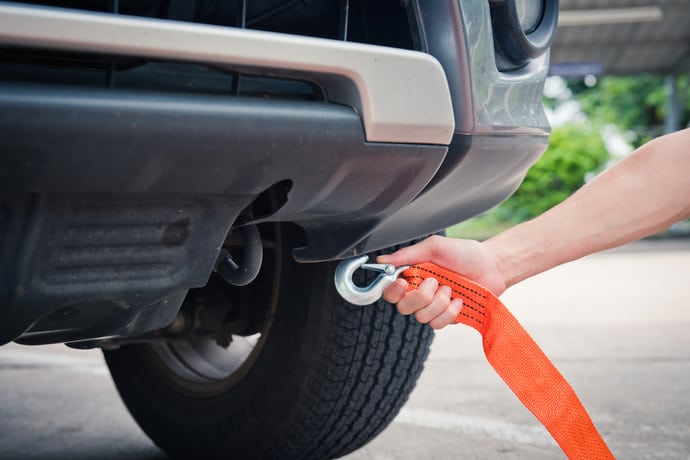Last Updated on August 26, 2022 by

There may come a time when you need to tow a vehicle. This can be for a number of reasons, including taking your vehicle with you on a trip, moving, or transporting that vehicle to another location. Whatever reason you might have for needing to tow a vehicle, you definitely need to know how to properly tow it without doing damage to the vehicle.
There are a few methods that you can follow, each with its distinct advantages and levels of ease. Follow these steps and you will be able to tow your vehicle successfully whenever you need to do so.
Options for Towing
Tow Rope or Straps
A tow strap is one of the most basic, cheapest and eassiet ways to get another car towed and off the road.
Tow Dolly
A tow dolly will let you tow a vehicle while allowing that towed vehicle to take some of the load off of the vehicle that is doing the towing. How is this accomplished? Well, the rear wheels rest on the ground as the vehicle is towed.
This generally works better when the towing vehicle is front wheel drive. This is because a rear wheel drive or four wheel drive vehicle means that you have to disconnect the drive shaft for longer distances. It is imperative that you know what the maximum tow capacity of your vehicle is and that you do not exceed it.
Using this method is fairly easy to implement. You need to attach the dolly coupler to the hitch ball on the vehicle that will do the towing. This means that you have to properly seat the coupler on the hitch ball and then tighten the coupler by hand until the connection is both tight and secure.
When the dolly is secure, you can load the towed vehicle. If possible, drive the towed vehicle onto the dolly ramp so that it is facing forward. Check all of your clearances to ensure that the vehicle is properly seated on the dolly.
Once you have secured the towed vehicle using tyre straps to secure the front tyres, all you have to do is disconnect the drive shaft and you are ready to tow.
Trailer
Unlike the tow dolly, this method means placing the entirety of the vehicle on the trailer so that it does not touch the ground during the towing process. You will need some wheel nets or nylon straps in addition to the trailer itself.
This is safer than other methods but it does have its drawbacks, one of which is that the vehicle and tow trailer together may be too heavy for the vehicle that is towing to handle. This is why it is important to know the tow rating of the vehicle that you intend on using. If it isn’t rated to tow weights that heavy, you will not be able to tow the vehicle.
To do this, you must first attach the trailer. This can be done by attaching the trailer to the hitch ball of the vehicle that will do the towing. You must make sure that the trailer coupler is secured tightly and that it is attached to the hitch by driving the tow vehicle slightly forward.
When you have done this, attach the safety chains that connect from the trailer to the tow vehicle itself. Then connect the trailer wiring harness to the sockets of the tow vehicle. Should the trailer come with a brake battery, you need to check its charge before you begin your journey.
After you have set up and attached the trailer, you will next need to load the vehicle itself. After you have extended the trailer ramps, you would then drive the tow vehicle up the ramp and onto the trailer itself. Make sure that the tow vehicle is centred by slowly driving the vehicle up the ramps.
Continue driving all the way up until the front tyres are resting against the tyre stops that sit at the front of the trailer itself. Then place the vehicle in park and make sure that you have set the parking brake.
The final portion of this is using wheel nets or nylon straps over the centre of the front tyres and ratcheting the straps down until they are secured tightly. Then you are ready to tow the vehicle where you need it to go.
Tow Bar
One of the last methods to tow a vehicle is by using a tow bar. Doing this allows all four wheels of the vehicle being towed to sit on the ground even when moving. When you use a tow bar, you need to make sure that you disconnect the drive shaft to ensure that the transmission does not become damaged.
More often than not, tow bars are used with caravans in order to tow a vehicle for eventual use while travelling long distances or cross-country. It is important to note that a tow bar means that you attach brackets to the front frame of the tow vehicle. This might not be something that you feel comfortable doing yourself; if you don’t, have an auto body technician do this for you.
You need to first secure the brackets. Find the strongest part of the vehicle frame to attach the bracket to, one on each side of the front. Then check the brake lights and turn signals to ensure that they work in tandem. You can purchase a wiring system that will connect to and coordinate with the lights and turn signals so that they will work together.
Lastly, attach the tow bar. After you have attached the tow bar brackets to the towed vehicle itself, you make certain that the bolts are secured using a socket wrench. After you attached the tow bar, make certain to secure it by attaching safety chains from the tow vehicle to the pivot bracket itself.
These are the safest and most secure ways to tow a vehicle, though each comes with its downsides and one is definitely more difficult than the others. Still, it beats having to have your vehicle towed to a location ahead of time if at all.
